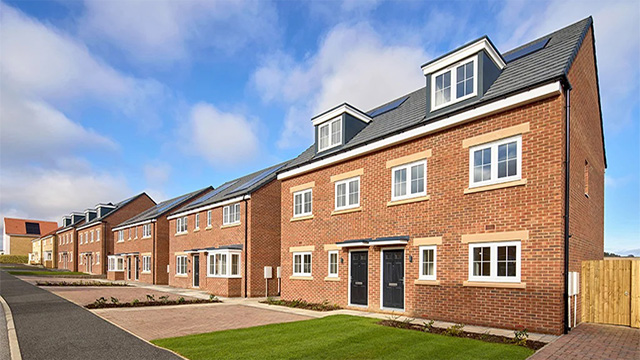The likes of Aareal and Hypo are following the EBRD into Romania, Russia and the Baltics
The European Bank for Reconstruction and Development (EBRD) is heading east. “To a large extent, our role in Poland, Hungary and the Czech Republic is exhausted,” says Ilaria Benucci, the EBRD’s head of tourism and property. “Our strategy is to expand in Russia, Ukraine, Romania, Bulgaria and Serbia.”
In 2004, Benucci’s team agreed to provide more than €200m to back property developments. In 2005, it wants to rebalance its portfolio so that 60-70% of new business comes from Russia, Romania and the Balkans.
The EBRD lends mainly on development projects, but its active presence in markets at the eastern edge of central and eastern Europe is a useful indicator of the maturity of the region’s property banking sector. For instance, the EBRD often acts as lead bank in a syndicate of commercial lenders. While foreign banks are increasingly present in these markets and willing to lend on property, the markets’ higher risk profile means that they still appreciate the hand-holding presence of the EBRD.
EBRD plugs a gap
The EBRD, which typically lends for a 10-year period, also plugs the gap between local bank finance – which tends to be restricted to three to five-year terms – and the longer-term needs of property projects. “We don’t want to crowd the market,” says Benucci. “If there were commercial banks in these markets, there’d be no need for us.”
But the EBRD’s raison d’etre is to lend itself out of business, and there are already signs that its role in these markets will soon diminish. The German and Austrian banks that made the EBRD’s role in Poland, the Czech Republic and Hungary a thing of the past are also moving east, in the wake of opportunistic investment clients seeking higher returns. After all, the unexpectedly fast compression of investment yields in the central European market has also reduced profit margins for the less conservative banks.
Dr Walter Hampel, head of central and eastern Europe for Germany’s Hypo Real Estate, sets the scene. “A significant number of investors that took positions [in Poland, the Czech Republic and Hungary] in the late 1990s are now exiting these markets. Now there’s a second generation of more conservative investors coming to central Europe, happy to buy at yields of 8%, and the more opportunity-driven investors are looking for short to medium-term investment positions in new markets.
Hypo Real Estate’s position is to follow its international clients into new markets such as Romania, the Baltic States and Moscow. “We are looking for business there but our approach is a careful one. We will probably go for some deals but in the early stages they will not form a dominant part of our central and eastern European loan portfolio.” Hypo Real Estate’s loan portfolio in the region is now worth €1.9bn.
It is one of three German banks that have declared their hands in the market. Eurohypo is considering opening an office in Moscow and has “a strong appetite” for Russia, Romania and Bulgaria. “We’re in the process of doing deals in all three markets,” says Markus Leininger, the bank’s head of central and eastern Europe. In Russia, it would also consider lending in St Petersburg and secondary cities such as Nizhny Novgorod, Kazan, Samara and Perm.
A different business culture
Eurohypo also realises that it is entering a market with a very different business culture. “The Russians have strong opinions about how they do business; the attitude is ‘we can manage by ourselves’,” says Leininger.
“There are lots of local players with big pockets – they’re not looking towards the Degis and DGIs of this world. As a foreign lender, it makes our life harder when working with local clients. Institutional investors that need to go through due diligence and investment committees can struggle to get deals on the hook, only to have someone local come along and put a better deal on the table.”
But Aareal Bank, based in Wiesbaden, is one step ahead. It has already provided debt financing on two Moscow investment deals, including acting as lead bank in a syndicate for the $43m refinancing of the recently completed 40,000m² Gostiny Dvor II centre.
“Positive economic signals and the increasing opening of the Russian market are stimulating the appetites of foreign investors,” says Dr Ralph Hill, a member of the banks’ management board. “Following extensive market surveys, this has persuaded us to be the first German property bank to take Russian loans onto our books.”
Estonia-based Hansabank, which is 60% owned by Sweden’s Swedbank, has already built up a strong position in property finance in Estonia, Latvia and Lithuania, particularly in the hotel and retail sectors. It has also completed four or five refinancing deals for Russian developers, and wants to “actively build up its banking presence in Moscow and St Petersburg. Within the next year, we plan to finance real estate quite extensively,” says Kaspars Delins, managing director for the bank’s St Petersburg operation.
Other non-Russian players likely to extend their involvement in property include Raffeissen Bank, which already has a $330m portfolio of residential and commercial mortgages in Russia; Bank Austria; and Anglo-Russian hybrid Moscow Narodny Bank.
According to Hypo Real Estate’s Hampel, market pricing offered by non-Russian banks has stabilised at 400-450 basis points above Libor for senior lending (on 65-70% loan-to-value ratios) compared to 140-150 points in Prague, Warsaw or Budapest.
He adds that the premium reflects the lack of liquidity in the financing market as much as an attempt to price in legal risks associated with property ownership. “Most of the laws are what you would expect -instruments to give security [over assets] – and the legal framework is surprisingly advanced. There’s always the question of how legal proceedings will be handled, but we share legal risks with our clients.”
The high margins that banks are managing to achieve is partly a sign of the immaturity of the Russian banking system. Nicolas Ollivant, director for corporate finance at Cushman & Wakefield Stiles & Riabokobylko in Moscow, says there are around 1,600 banks in Russia while the market can realistically support only 200-300.
The banks’ lending capacity is extremely limited, and they lack access to staff with knowledge and experience in property financing. As a result, they are interested in short term financing, lending for just two or three-year terms at 15% interest rates. “The Russian banking system is another constraint on the property market,” says Ollivant.
Viktor Makshantsev, capital markets associate director at Jones Lang LaSalle’s Moscow office, identifies Russian banks Alfa and MDM as the most active in the property sector. Their interest rates stand at 12-14% with amortisation periods of no more than five years.
“The lack of competitive debt financing is a major issue in the market,” Makshantsev says, but adds that competition from Austro-German rivals will soon force Russian banks to change. “At the moment they know that people will borrow on their terms, so why change?”
Lack of product in the Baltics
In Estonia, Latvia and Lithuania, would-be investors are more likely to be frustrated by lack of product than lack of finance. Herbert Spangler, Invesco’s central European head of structured finance, says: “A portfolio in these countries is difficult to handle from an asset management point of view. But I don’t think it would be a problem to get a loan, albeit with higher conditions than in central Europe’s established markets.”
Hampel, however, does not attach a price premium to the Baltics. “There’s no reason for borrowing in the Baltic states to be priced differently from in the Czech Republic or Poland. They are part of the EU, and most of the office and retail schemes have western tenants. However, they suffer from being small, when investors are looking for minimum lot sizes of €20-30m,” he says.
The bank is working on two deals in the region, while Eurohypo has already financed two deals in the Baltic states.
Romania and Bulgaria benefit from being seen as the EU’s eastern annexe: along with Croatia, they are expected to join in 2007. “There is a higher level of harmonisation with the EU [than in Russia]; we feel the same confidence operating there as in central Europe,” says Eurohypo’s Leininger. The bank has already concluded a deal in Bulgaria and is working on one in Romania.
Romania in particular is seen as having a bright property future. “Romania is the next big thing,” asserts the EBRD’s Benucci. “The people looking for high returns have now moved on to Romania. There’s a lot of interest from the usual suspects – Heitman, Investkredit – and all the big international logistics operators who see it as a logistics hub for the region. We receive a lot of investment proposals in this sector.”
The EBRD has already participated in a forward-funding investment transactions in the Romanian logistics sector. It has a 25% stake in the €300m Europolis E2 fund, with the rest owned by Bank Austria’s Investkredit Bank. Last November, Europolis paid Italian developer Cefin Real Estate €75m for the partially completed 150,000m² Cefin Logistic Park in Bucharest at a yield estimated to be 13%.
Europolis’s E2 fund plans to assemble a portfolio of 15 to 20 assets in Russia, the Ukraine, Bulgaria, Romania, Croatia and the former Yugoslav states, and will be looking for bank finance to leverage the total value of the portfolio to around €1bn. Given the ongoing evolution of the region’s banking market, its chances of achieving these goals seem reasonable.










